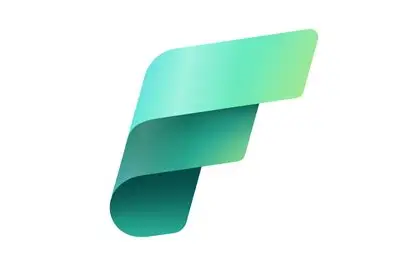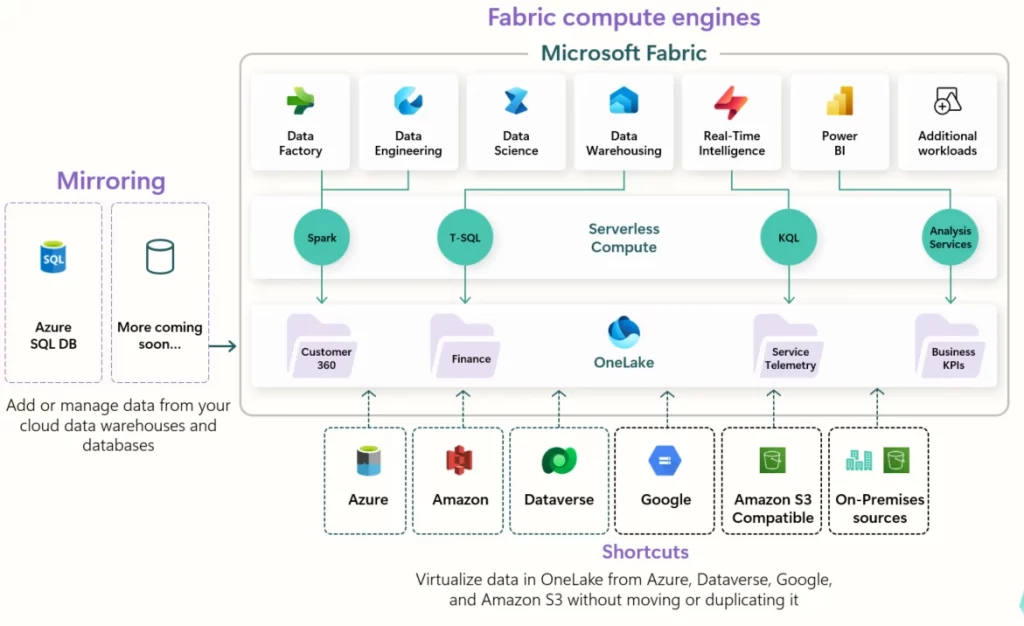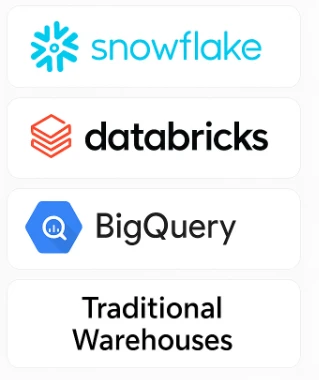Learn About Microsoft Fabric
What is Microsoft Fabric?
Microsoft Fabric is an all-in-one, AI-powered data analytics platform that unifies data services into a single software-as-a-service (SaaS) environment. It simplifies the entire data lifecycle—from ingestion to visualisation—by offering a streamlined and integrated experience. Instead of managing separate tools for integration, storage, analytics, and reporting, Fabric provides a cohesive solution that reduces complexity and accelerates the time to business insight.
At its core, Microsoft Fabric brings together Power BI, Azure Data Factory, and Synapse Analytics, giving organisations a central platform for data engineering, real-time analytics, and governance. The platform delivers faster development, enhances collaboration, and promotes more agile decision-making.

The History of Microsoft Fabric
Microsoft Fabric was first introduced in May 2023, when Microsoft announced its public preview as part of a vision to unify the modern data stack. Until then, Microsoft had offered powerful yet separate tools—Power BI for business intelligence, Azure Synapse for analytics, and Azure Data Factory for integration. While each was effective in its own right, organisations often faced additional effort and complexity when linking them together within the Azure ecosystem.
Fabric addressed this challenge by consolidating these services into a single, SaaS-based platform. It became generally available in November 2023, building on the popularity of Power BI and extending Microsoft’s capabilities into a comprehensive analytics environment. Since then, Fabric has continued to evolve, with frequent updates that enhance both its technical depth and AI-driven functionality.
Key Features and Components
Microsoft Fabric eliminates the fragmentation that often arises from managing many systems. By delivering all components under one umbrella, it creates a seamless experience for analysts, engineers, and business leaders alike. The team tailors the core components to different roles and tasks. This section lists the Microsoft Fabric features.

How Microsoft Fabric Works
Data Integration and Engineering
Fabric enables businesses to ingest, prepare, and transform data from multiple sources into a single environment. Its orchestration capabilities ensure that data is consistently available and ready for use.
Data Warehousing and Real-Time Analytics
Fabric offers a scalable, cloud-native data warehouse for advanced analytics alongside tools for real-time insight. This makes it suitable for diverse scenarios, from monitoring supply chains to analysing customer behaviour.
Governance and Security
Governance is built into Fabric, with features such as role-based access control, data lineage, and enterprise-grade security—ensuring compliance while maintaining accessibility.
To find out more visits the Microsoft Fabric Documentation.
Microsoft Fabric and Data Mesh Architecture
Fabric supports data mesh principles by enabling domain-oriented ownership of data products across the enterprise. Instead of managing data centrally through a single team, Fabric allows business units to govern and publish their own data products, while still integrating seamlessly through shared infrastructure.
Is Microsoft Fabric Right for Your Business?
Ideal Scenarios
Microsoft Fabric is well-suited for organisations that:
- Already use Microsoft technologies extensively.
- Require a single source of truth across business functions.
- Seek to leverage AI-driven insights for competitive advantage.
Potential Limitations
Fabric may not be the right fit for every organisation. For smaller businesses with limited data complexity, its comprehensive scope could add unnecessary cost and complexity compared to lighter BI tools. Additionally, as a rapidly evolving platform, many features remain in preview, meaning not all capabilities are fully mature. Advanced engineering functionality is improving and many items are on the Microsoft Fabric roadmap but may still lag behind long-established specialised platforms. Legacy technical debt within organisations can also slow adoption.
Key Questions to Ask
Before adopting Fabric, consider:
Can your teams manage the pace of change as Fabric continues to evolve?
Do you need to consolidate fragmented data sources?
Will AI-driven analytics deliver measurable business value?
Is scalability critical to your long-term data strategy?
Microsoft Fabric vs Other Analytics Platforms
When compared with other platforms, Fabric’s primary advantage is its integrated SaaS model:
- Snowflake: Known for its powerful cloud-native data warehouse and cross-cloud capabilities, Snowflake excels at storage efficiency and SQL performance. However, it is primarily a warehouse and requires additional tools for integration and visualisation. Fabric covers these areas natively.
- Databricks: Favoured for advanced data engineering and machine learning, Databricks is strong in AI workloads but often requires deep technical expertise, and historically this required separate BI integration. Fabric offers Spark-based analytics with the added benefit of seamless integration with Power BI and Microsoft 365.
- Google BigQuery: Google’s fully managed data warehouse is highly scalable and integrates tightly with the wider Google Cloud ecosystem. It delivers fast SQL-based analytics and includes native machine learning extensions. However, BigQuery typically requires additional tools for orchestration, governance, and business intelligence visualisation. Fabric provides these elements as part of its unified platform.
- Traditional Warehouses: Legacy warehouses focus on SQL reporting but lack real-time, AI-driven, and scalable features. Fabric provides these capabilities in one cohesive platform.
In short, Fabric reduces the need for multiple vendors and tools by providing an end-to-end analytics environment that connects directly to the wider Microsoft ecosystem.


Microsoft Fabric Pricing Model
Fabric follows a consumption-based pricing model, offering flexibility and scalability:
This transparent model gives businesses predictable cost control while aligning with cloud-first strategies.
Find out from Microsoft about the Fabric pricing
Getting Started with Microsoft Fabric
At Responsive Analytix, we help organisations evaluate and implement Microsoft Fabric to ensure it aligns with their business strategy. Our services include:
Enablement: Training teams to adopt and make the most of the platform.
Advisory: Assessing your current data estate and goals.
Implementation: Designing and delivering Fabric-based architectures.
Contact Responsive Analytix today to discuss how Microsoft Fabric can transform your data strategy and unlock insight-driven decision-making.
Ready to Explore Microsoft Fabric?
Contact Responsive Analytix for a tailored assessment of your data strategy.
Find out about what about Microsoft Fabric on the Microsoft Site.
